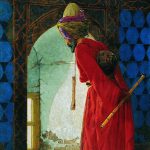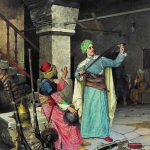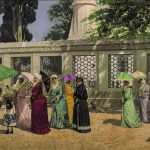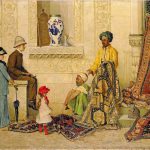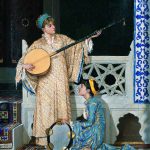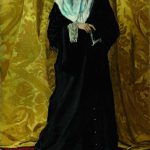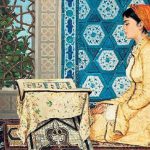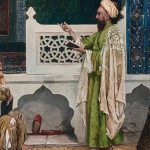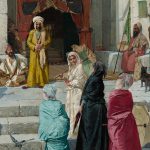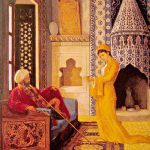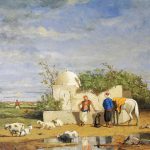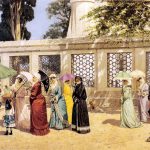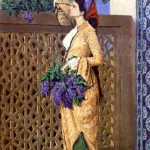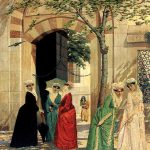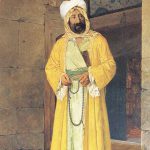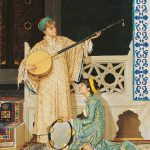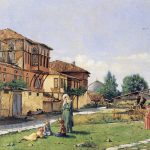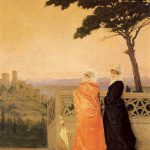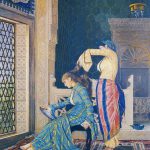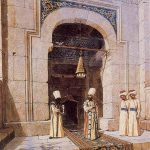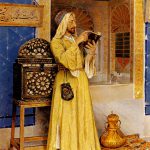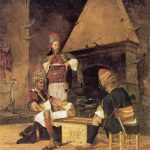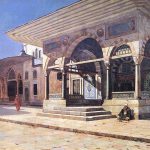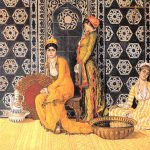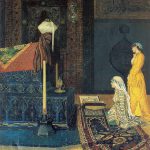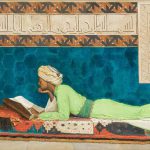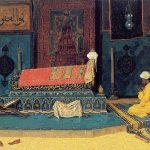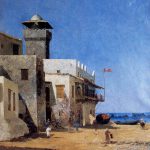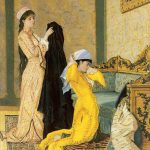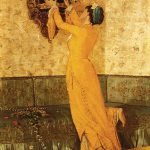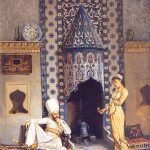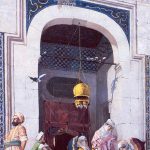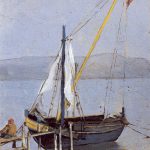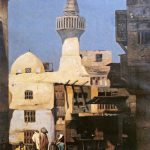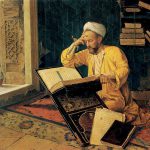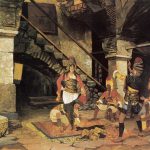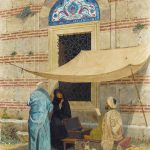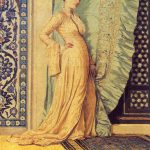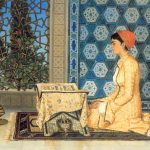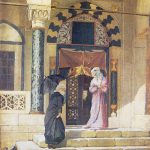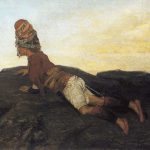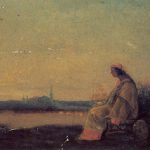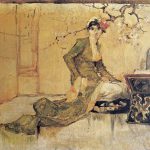
Who is Osman Hamdi Bey?
He is the son of Ibrahim Ethem Pasha, one of the Ottoman grand viziers of Greek origin who came from Chios Island as an adopted child, and is the older brother of Istanbul Member of Parliament, mayor, museum curator, chemist and philosopher Halil Ethem Bey and numismatist Ismail Galip Bey.
He is considered the first Turkish archaeologist. After carrying out his first archaeological studies in Baghdad, he ensured the foundation of modern archaeological science in the Ottoman Empire by ensuring that the necessary law was passed and taking control of all archaeological studies.[3] The most important archaeological excavation was the Sidon King Cemetery (Lebanon) excavations carried out in 1887-1888. During these excavations, he found the world-famous Alexander Sarcophagus.
Osman Hamdi Bey was the director of the Istanbul Archeology Museum for 29 years and added the museum to the world’s leading museums[citation needed]. Those who consider Osman Hamdi Bey the founder of modern Turkish museology justify this by being the first Turkish museum director during the Ottoman period and developing the museum.
He is also the founder of Sanayi-i Nefise Mekteb-i Alisi, which continues its existence today as Mimar Sinan University Faculty of Fine Arts. He is one of the first Turkish painters and went down in history as the first painter to use figured composition in Turkish painting and is the owner of the work Turtle Trainer.
His family primarily played a role in Osman Bey's versatile upbringing. Like his father, Grand Vizier İbrahim Ethem Pasha, he had the opportunity to receive his education in Europe. It is said that İbrahim Ethem, the first mining engineer of the Ottoman Empire, was a Greek [4][5] child recruited after the suppression of a rebellion in Chios. When he was brought to Istanbul, he was taken in by his captain Derya Hüsrev Pasha and started to be trained. Hüsrev Pasha, who had no children, tried to raise the children he took with him very well. In 1829, when İbrahim Ethem was only 9-10 years old, he joined the first children sent to France for education by Hüsrev Pasha.[6] İbrahim Ethem served as Minister of Foreign Affairs, Minister of Commerce, Governor, Berlin Embassy, Vienna Embassy, Tanzimat Assembly member, Council of State member, State Council member and Grand Vizier, and was Sultan Abdülmecit's French teacher. It is also rumored that he was a classmate of Pasteur.
The names of the three brothers of Osman Hamdi Bey, who is the eldest of the four children of İbrahim Ethem, who married Fatma Hanım, the daughter of Sultan Abdülmecit's Yağlıkçılar Butler Hacı Mustafa Ağa, are Halil Ethem, İsmail Galip and Mustafa. Mustafa Bey, the youngest and least famous, becomes the Director of Istanbul Customs.
Osman Bey's brother, Halil Ethem Eldem (1861-1938), studied chemistry and then received his doctorate in philosophy. Then he worked in museology, Ser Askerlik Factories Consultancy, General Staff Department Translation Branch officer, Istanbul Şehremini, Asar-ı Atika Museums Directorate, Darülşafaka, Mülkiye Mektebi, He worked as a Natural Science and Geology Teacher at Darü'l-Muallimin and Darülfünun, as Director of Sanayi Nefise School, as a Member of the Ottoman History Committee, as a Member of the Turkish History Committee at the Ministry of Education, as a Founding Member and Vice-President of the Turkish Historical Research Society, and as an Istanbul Deputy in the 4th and 5th Term of the Grand National Assembly of Turkey. IV. He was active in a wide variety of fields, such as being the Chairman of the Library Committee in the 5th Term.
His other brother, İsmail Galip Bey (1848-1895), is considered the founder of the scientific discipline of numismatics in Turkey.
His daughter Nazlı Hamdi (1893–1958) married Esat Cemil, an Ottoman diplomat. Their daughter, Cenan Hamdi Sarç (1913-2012), married the rector of Istanbul University, Ömer Celal Sarç.
Edhem Eldem, the great-grandson of his brother İsmail Galip, is a faculty member at the Department of History at Boğaziçi University. He taught as a visiting professor at Berkeley, Harvard, École des Hautes Études en Sciences Sociales, École Pratique des Hautes Études and École Normale Supérieure, and Berlin. He worked as a researcher at the Wissenschaftskolleg in 1998 and produced many scientific works.
life
He was born on December 30, 1842 in Istanbul. His father, İbrahim Ethem Bey, one of the country's first mining engineers, was a statesman who rose to the rank of grand vizier in 1877. Osman Hamdi is the eldest of the family's six children, two of whom are girls. One of his brothers, Mustafa Bey, became Istanbul customs director, İsmail Galip Bey, one of the founders of numismatics in Turkey, and Halil Ethem Bey, a museum curator.
After completing his primary school education, Osman Hamdi started attending the Maarif-i Adliye school in 1856. He attracted the attention of those around him with the pencil drawings he made when he was only 16 years old. He was interested in museums and exhibitions in Vienna, where he went with his father. His father, who wanted his sons to study abroad, sent him to Paris a few years later to study law. While he was studying law during his 12-year stay in Paris, he received a good painting education by apprenticing in the workshops of Jean-Léon Gérôme and Boulanger, two of the famous painters of that period. During his stay in Paris, the Ottoman Empire sent Şeker Ahmet Pasha and Süleyman Seyyid to Paris to study painting. These three people formed the first generation of Turkish painting.[12] Osman Hamdi Bey sent three of his works, "The Break of the Gypsies", "Pusuda Zeybek" and "The Death of Zeybek", to the 1867 Paris World Exhibition, whose whereabouts are unknown today.[13] He was married to his wife, Marie, whom he met and married in Paris, for 10 years, and they had two daughters, Fatma and Hayriye.
After returning home, he worked at different levels of government. His first assignment was the Baghdad Province Foreign Affairs Directorate. He made paintings reflecting the various views of this city, where Mithat Pasha came to Baghdad because he was governor, and was interested in the history and archeology of Baghdad. He met and became friends with the future famous novelist Ahmet Mithat Efendi, who was the assistant of the governor Mithat Pasha at that time.
Osman Hamdi, who became Deputy Director of Protocol at the Palace when he returned to Istanbul, attended the International Exhibition held in Vienna as a commissioner. He made his second marriage to another French lady, whose name was Marie, whom he met while in Vienna. His second wife, named Naile Hanım, gave birth to children named Melek, Leyla, Ethem and Nazlı.
In 1875, he was appointed as the first mayor of Kadıköy and held this position for one year.
Osman Hamdi Bey, who retired early from the civil service after the Ottoman-Russian War, devoted himself to painting in his house in Eskihisar village of Gebze. Following the death of Anton Dethier, the director of the Museum-i Hümayun (Imperial Museum), in 1881, although Osman Hamdi Bey was not initially considered as the director of the museum, he was appointed to this position by the sultan under the influence of the grand viziers of the period.
On January 1, 1882, Sultan II. Abdulhamit was appointed to another position. He was appointed as the director of Sanayi-i Nefise Mektebi, Turkey's first fine arts school. He designed the school building together with Architect Vallaury. After the construction of the building and the establishment of the academic staff, he opened the school for education on March 2, 1883.
His first job as the director of the Imperial Museum was to prepare a regulation prohibiting the taking of antiquities abroad. He reorganized and put into effect the "Antiquities Regulation" dated 1874, which was in force in 1883. With this new regulation, he prevented the smuggling of antiquities from Ottoman lands to Western countries.
Osman Hamdi Bey, who initiated the first Turkish scientific excavations while he was the museum director, carried out archaeological excavations in Mount Nemrut, Lagina (Muğla, Yatağan) and Sayda (Lebanon). Among the ancient artifacts he found during his excavations in Sayda is the Alexander Sarcophagus, which is considered one of the masterpieces of the archaeological world. The works in question are exhibited in the Istanbul Archaeological Museum. Regarding these excavations, which brought him international fame, Osman Hamdi Bey wrote a book called "Une necropole a Sidon (Sidon King Cemetery)" together with archaeologist Salomon Reinach and had it published in Paris in 1892.
Osman Hamdi Bey also assigned his close circle to various excavations. During the excavations carried out by his son, Architect Ethem Bey, in the ancient city of Tralles (Güzelhisar, Aydın), friezes of a temple attributed to the Ancient Greek god Artemis and many other works were unearthed and brought to the Imperial Museum. He assigned his brother Halil Ethem Bey to lead the excavations in the ancient cities of Alabanda and Sidamara in Aydın. Makridi Bey, one of the museum officers, carried out the excavations in Rakka, Boğazköy, Alacahöyük, Akalan, Langaza, Rodos, Thassos and Notion.
Osman Hamdi Bey searched for a new building to exhibit the increased artifacts resulting from the excavations. The works were moved to the Tiled Kiosk after Hagia Irene, but this place was also inadequate. He persuaded the rulers of the time and built the present-day Istanbul Archeology Museum building. The first part of the museum building, which was completed in three stages, was opened to visitors in 1899, the second part in 1903, and the third part in 1907. He had a photography studio, library and model room built within the museum.
The Imperial Museum had become a museum focusing on archaeology. The weapons and military equipment in the collection were left in Hagia Irene and were organized under the name "Esliha-i Military Museum". This new museum, which is the basis of today's Military Museum, was opened to visitors in 1908. The artifact warehouses established by Osman Hamdi Bey in cities outside Istanbul became the basis of regional museums to be established in the future. Sanayi Nefise School began to form the core of the Fine Arts Museum by collecting the works of its students in the large hall of the school. All these efforts made him the founder of modern Turkish museology.
Osman Hamdi Bey never stopped painting while continuing his museology and archeology studies. He generally painted his paintings during the summer months he spent at his home in Gebze, Eskihisar. He was the first painter to use figured composition in Turkish painting.[13] In his paintings, he dealt with the type of Turkish intellectuals he longed for, who read and discussed, and the image of women who were open to the outside world. He used historical buildings as decoration and historical items as accessories. "Turtle Trainer" (1906) and "Arms Dealer" (1908) are among Osman Hamdi's most interesting and original works. Many of his paintings are exhibited in the Istanbul Painting and Sculpture Museum, London, Liverpool and Boston museums.
The artist died on February 24, 1910, in his mansion in Kuruçeşme, Istanbul. After the funeral prayer performed in Hagia Sophia, his body was brought to the Çinili Köşk, where the museum is located, and was buried in Eskihisar, according to his will. Two anonymous Seljuk stones were placed at his grave by the decision of the Council of Ministers.[18] The artist's mansion in Eskihisar has been serving as a museum since 1987.
Studies done about it;
"Turtle Trainer" documentary, directed by Umut Hacıfevzioğlu and written by Emre Caner
The website prepared in his memory by the Ministry of Culture and Tourism was archived at the Wayback Machine on 6 May 2013.
"Nazlı's Notebook, Osman Hamdi Bey's Circle" by Prof.Dr. The exhibition curated by Edhem Eldem and the book of the same name, Homer Bookstore.
Photographer Neslihan Sağır Çetin photographed Osman Hamdi Bey's works by recreating them with models in the places he painted. The first exhibition of this project called Resm'i Mekân was opened in Bursa.
